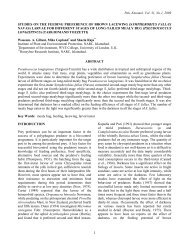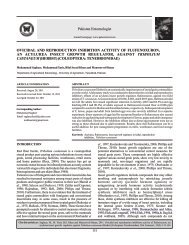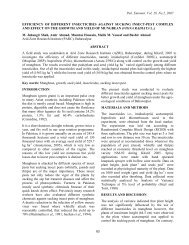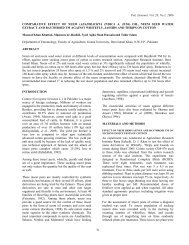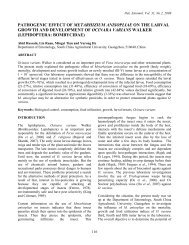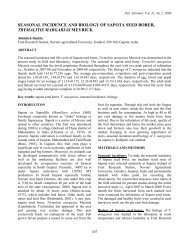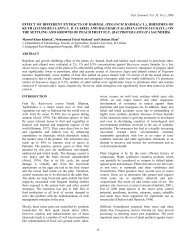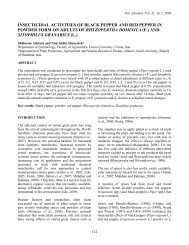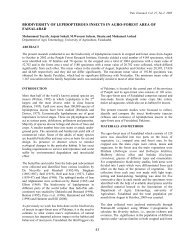Entomol. Journal Page Setting, all articles - Pakistan Entomologist
Entomol. Journal Page Setting, all articles - Pakistan Entomologist
Entomol. Journal Page Setting, all articles - Pakistan Entomologist
Create successful ePaper yourself
Turn your PDF publications into a flip-book with our unique Google optimized e-Paper software.
Manzoor et al. / <strong>Pakistan</strong> <strong>Entomol</strong>ogist 2011, 33(2): 125-130<br />
parasitoid female, such as: venom and polydnaviruses needs, ecological adaptation and developmental<br />
(PDVs) (Pennacchio and Strand, 2006).<br />
characteristics. It is used as a host in favor of many<br />
hymenoptera species (Burges, 1978; Smith, 1965; Haewoon<br />
The parasitic form of life is very prolific and has evolved in<br />
et al., 1995; Coskun et al., 2006; Dweck et al., 2010;) The<br />
copious orders of arthropods. In parasitic insects adults are<br />
present study was carried out with the aim to evaluate the<br />
free living and a few numbers of progeny develop per host.<br />
biological activity of the venom of the wasp. .<br />
The hosts are not survived during the encounters so many<br />
parasitic insects are different from other parasitic organisms<br />
(Vinson, 1975).<br />
MATERIALS AND METHODS<br />
Regulation of host by insect parasitoids is a multifaceted<br />
procedure which consequences in a common physiological<br />
condition, ultimately increasing the suitability of the host<br />
Rearing of host parasitoid culture<br />
(Vinson and Iwantsch, 1981). According to their origin and<br />
The ectophagous larval parasitic wasp Bracon hebetor (Say.)<br />
function, there are different categories of host regulation<br />
(Hymenoptera: Braconidae) was reared under laboratory<br />
factors. Adult parasitoid females produce maternal origin<br />
th<br />
conditions on the mature larvae (5 instar) of greater wax<br />
factors that are injected at the time of oviposition, while<br />
moth G<strong>all</strong>eria mellonella (Lepidoptera: Pyralidae) by<br />
factors belonging to embryonic origin are obtained from the<br />
following a slightly modified approach as described by Alserosal<br />
membrane or from the other tissues associated with<br />
Tememi, 2005; Khan et al., 2005; Ahmed and Ahmad, 2006.<br />
embryo. Host physiology is also regulated by the parasitoid<br />
The adults of the parasitoid, B. hebetor were collected directly<br />
larvae.<br />
from fodder Trifolim alexandrium L., located at the campus of<br />
The host-parasitoid association that was considered in the the University of Agriculture, Faisalabad, <strong>Pakistan</strong>. The<br />
present study is Bracon hebetor (Say.) (Hymenoptera: collected parasitoids were identified on the basis of their<br />
Braconiodae) and G<strong>all</strong>eria mellonella (L.) (Lepidoptera: morphological characters. This parasitoid has two<br />
Pyralidae). Bracon hebetor (Say.) is a gregarious, phenotypes, depending on the temperature. During summer<br />
arrhenotokous, idiobiont, ectoparasitoid wasp, attacking the season, the adults have brownish colour while, during winter<br />
larvae of lepidopterons (Tuncyurek, 1972; Cline et al., 1984; season, the adults have blackish colour (Ahmed et al., 1985).<br />
Gul and Gulel 1995; Heimpel et al., 1997; Darwish et al., The larvae, pupae and adults of the host, G. mellonella were<br />
2003). It has been widely used in studies of host parasitoid collected from the infested bee hives located at the campus of<br />
interactions because of its high reproductive rate, short University of Agriculture, Faisalabad, <strong>Pakistan</strong>. The host and<br />
generation time and significant range of host species parasitoid cultures were maintained in two separate glass jars,<br />
o<br />
(Tuncyurek, 1972; Gul and Gulel, 1995). B. hebetor (Say) both were kept at 27-30 C±1, 65±5% temperature, relative<br />
completes its development on different species of humidity (RH) and 18 h light /6 h dark photoperiod.<br />
Lepidopteran larvae by using gener<strong>all</strong>y Pyralidae The culture of the parasitoid was reared on the larvae of the<br />
(Lepidoptera) larvae as host . Most of the species of Pyralidae greater wax moth G. mellonela as a host by using glass vials of<br />
(Lep.) are agricultural pests on some field and storage crops. (2×10 cm) in the insect molecular biology laboratory,<br />
Toxic bio-active peptides are present in the venom of the Department of Agri. <strong>Entomol</strong>ogy, University of Agriculture,<br />
th<br />
B.hebetor which blocks the neuromuscular transmissions in Faisalabad. Each vial contains 2 to 3 of to 5 instar larvae of<br />
larvae of lepidopteran species by inhibiting exocytosis of pre the host and one female of the parasitoid, provided with cotton<br />
synaptic vesicles (Piek, 1966; Walther and Reinecke, 1983). swabs/pads soaked in 50% honey and water as food source for<br />
Its females have a preference to attack last (fifth) instar of host adult of B. hebetor. The females of the parasitoid start to<br />
larvae (Benson, 1973). The host is first injected with venom parasitize the larvae of the host by first injecting a sm<strong>all</strong><br />
th<br />
that induces entire and everlasting paralysis within 15 quantity of paralyzing venom into mature (5 instar) larvae of<br />
minutes (Piek, 1966; Piek et al., 1974). After host-feeding, a the host before egg laying on them, which induces partial or<br />
female lays between 5 and 25 eggs per host depending upon complete paralysis and then deposit between 3 to 20 eggs on<br />
the size of the host, host-encounter pace, and physiological the outside of the host. After parasitism, the larvae of the host<br />
state of the ovipositing female (Benson, 1973; Hagstrum and become sluggish and later on, the females start egg laying on<br />
Smittle, 1977) . Females lay eggs on the host body and after these larvae. After 24 hours, the parasitized larvae of the host<br />
hatching the eggs, the larvae of the parasitoid produce silken were shifted from the vials to new sterilized glass jars (9×5<br />
cocoons and pupate outside the body of the host. Adult wasps cm) by using brush, provided with wax, pollen and honey as<br />
emerge from pupae ~16 days after oviposition.<br />
food for developing host larvae by keeping at the same<br />
The greater wax moth, G<strong>all</strong>eria mellonella (L.) (Lepidoptera: environmental conditions stated as above and the females of<br />
th<br />
Pyralidae) is an economic<strong>all</strong>y vital pest of the honeybee and is the parasitoid were shifted to new vials containing 2-3 (4-5<br />
one of the most devastating pests of wax in the world. Moth's instar) larvae of the host for further parasitization and this<br />
larval stages feed on wax, honey and pollen thus causing process remained continue until the last moment of the female<br />
serious economic damage as they tunnel through the comb. life. The eggs were hatched within 2-3 days into transparent<br />
The larvae of the wax moth, cause considerable damage to larvae, which were directly bored into the body of the host<br />
combs left unattended by bees (Caron, 1992). G. mellonella is larvae for feeding. These larvae, after completing their<br />
preferred in entomological studies, because of its nutritional feeding/development came out the host body for pupation.<br />
Cite this article as:<br />
Manzoor, A., Zain-ul-Abdin, M. Arshad, M.D. Gogi, H. Shaina, E. Mubarik, S.K. Abbas and M.A. Khan, 2011. Biological activity<br />
of the toxic peptides from venom of Bracon hebetor (Say.) (Hymenoptera: Braconidae). Pak. <strong>Entomol</strong>., 33(2): 125-130.<br />
126



